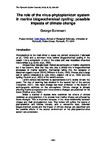The role of the virus-phytoplankton system in marine biogeochemical cycling: possible impacts of climate change
| dc.contributor.author | Sorensen, G. | |
| dc.date.accessioned | 2019-05-13T13:41:38Z | |
| dc.date.available | 2019-05-13T13:41:38Z | |
| dc.date.issued | 2009 | |
| dc.identifier.citation |
Sorensen, G. (2009) 'The role of the virus-phytoplankton system in marine biogeochemical cycling: possible impacts of climate change', The Plymouth Student Scientist, p. 289-302. | en_US |
| dc.identifier.issn | 1754-2383 | |
| dc.identifier.uri | http://hdl.handle.net/10026.1/13883 | |
| dc.description | Phytoplankton is the main driver of ocean net primary production (Falkowski et al., 1998) and a dominant force behind biogeochemical cycling in the ocean. It is a component of one of the oldest and best described virus-host relationships (e.g. Suttle et al., 1990). Viruses have typically been viewed as pathogens of marine organisms but it has become clear that they also play a critical role in biogeochemical processes in marine systems, themselves falling into the category of dissolved organic matter (DOM) (Wilhelm & Suttle, 1999). Viruses play a large part in carbon (Middelboe & Lyck, 2002), sulphur (Hill et al., 1998) and iron cycling (Poorvin et al., 2004) in the world‟s oceans. Earth‟s climate has warmed by approximately 0.6°C during the last 100 years. The rate of warming has doubled in the second half of the century (Houghton, 2001). This rapid change has been attributed to the impact of anthropogenic activities on the atmosphere. Climate change is already affecting marine ecosystems and more extreme changes are predicted for the future (Walther et al., 2002). Whilst a number of studies have examined the effects of climate variables on phytoplankton, it is unclear how marine viruses are affected by these changes. This is important because of the close relationship between viruses and their phytoplankton host. This review will outline the nature of phytoplankton and marine viruses, with a virocentric bias. Relevant biogeochemical cycles and the impact of climate change are described and the possible effects of the altered environment on the phytoplankton-virus system are considered. | en_US |
| dc.language.iso | en | en_US |
| dc.publisher | University of Plymouth | |
| dc.rights | Attribution 3.0 United States | * |
| dc.rights.uri | http://creativecommons.org/licenses/by/3.0/us/ | * |
| dc.subject | climate change | en_US |
| dc.subject | impact | en_US |
| dc.subject | virus | en_US |
| dc.subject | phytoplankton | en_US |
| dc.subject | marine | en_US |
| dc.subject | biogeochemical | en_US |
| dc.subject | virus-phytoplankton | en_US |
| dc.subject | Viral lysis | en_US |
| dc.subject | Biogeochemical Cycles | en_US |
| dc.subject | carbon cycle | en_US |
| dc.subject | sulphur cycle | en_US |
| dc.subject | iron cycle | en_US |
| dc.title | The role of the virus-phytoplankton system in marine biogeochemical cycling: possible impacts of climate change | en_US |
| dc.type | Article | |
| plymouth.issue | 2 | |
| plymouth.volume | 2 | |
| plymouth.journal | The Plymouth Student Scientist |



